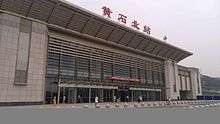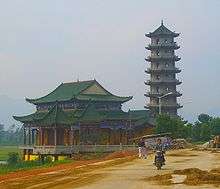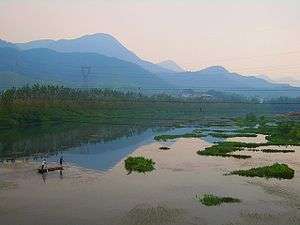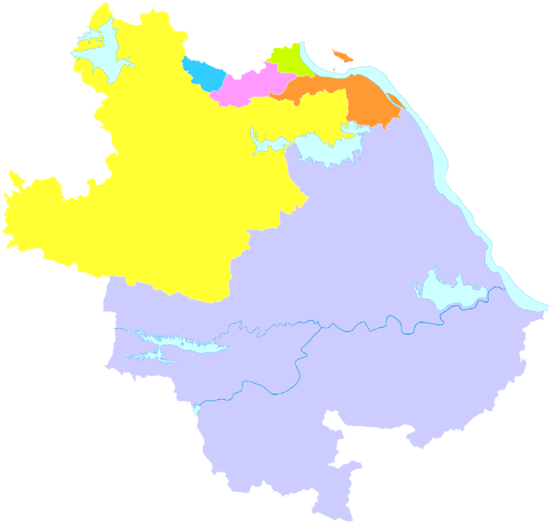Huangshi
| Huangshi 黄石市 | |
|---|---|
| Prefecture-level city | |
|
On the Fushui River (Yangxin County) | |
.png) Location of Huangshi City in Hubei and the PRC | |
 Huangshi Location in Hubei | |
| Coordinates: 30°13′N 115°05′E / 30.217°N 115.083°ECoordinates: 30°13′N 115°05′E / 30.217°N 115.083°E | |
| Country | People's Republic of China |
| Province | Hubei |
| Area | |
| • Prefecture-level city | 4,582.85 km2 (1,769.45 sq mi) |
| • Urban | 233.8 km2 (90.3 sq mi) |
| • Metro | 1,800.1 km2 (695.0 sq mi) |
| Population (2010 census[1]) | |
| • Prefecture-level city | 2,429,318 |
| • Density | 530/km2 (1,400/sq mi) |
| • Urban | 691,963 |
| • Urban density | 3,000/km2 (7,700/sq mi) |
| • Metro | 1,601,687 |
| • Metro density | 890/km2 (2,300/sq mi) |
| Time zone | China Standard (UTC+8) |
| Licence plate prefixes | 鄂B |
| Website |
huangshi |
Huangshi (simplified Chinese: 黄石; traditional Chinese: 黃石; pinyin: Huángshí) is a prefecture-level city in southeastern Hubei province, People's Republic of China. Its population was 2,429,318 inhabitants at the 2010 census; 1,601,687 of whom lived in the built-up (or metro) area made up of 4 urban districts plus the city of Daye, now being part of the agglomeration.
Geography and climate
Huangshi is located in southeastern Hubei province, along the southwestern bank of one of the major bends in the Yangtze River. It is located 100 kilometres (62 mi)[2] south-east of Wuhan, and borders Jiangxi province to the south. Its area was reported by the local government as 4,583 square kilometres (1,770 sq mi);[3] elsewhere, the number of 4,630 square kilometres (1,790 sq mi) was given. The terrain is mostly small mountains and hills. The tallest mountain is 7 Summit Mountain with an elevation of 860 metres (2,820 ft) above sea level. Huangshi is also located in a major lake district between Hunan's Dongting Lake and Jiangxi's Poyang lake and has dozens of large lakes. Huangshi's climate is sub-temperate. Average annual temperature is 17 °C (63 °F) and precipitation is 1,400 mm (55.1 in). There are 264 frost free days. It snows between December and February.
Administration
Huangshi has 4 districts, 1 county, and 1 county-level city.
City:
- Daye (大冶市)
Districts:
- Huangshigang District (黄石港区)
- Xisaishan District (西塞山区)
- Xialu District (下陆区)
- Tieshan District (铁山区)
County:
- Yangxin County (阳新县)
| Map |
|---|
Demographics
According to the Fifth Population Census of China (2000), the entire prefecture-level city of Huangshi had 2,476,400 people, making for the population density of 540 people per square kilometer.[4] More than 99% of the population belong to the Han ethnic group.
According to Google Map there are 686.894 people in Huangshi; this refers, presumably, to Huangshi's urban core (Huangshigang District 196,600 people, density 5757 people /km2; West Fort Mountain (Xisaishan) Area, 244,000, density 2171 people /km2; Xialu District, 146,600 people, density 2536 people /km2),[4] and excludes the far-flung Yangxin County, Daye, and Tieshan.
Economy
Huangshi's GDP for 2003 was 27.5 billion CNY. Its proximity to Wuhan and location along major rail lines and the Yangtze River make Huangshi an important logistics, distribution, and transportation hub. Mineral resources are plentiful in Huangshi giving it the nickname "The Southern Cornucopia". Metals include iron, manganese, gold, copper, tungsten, molybdenum, zinc, lead, cobalt, silver, gallium, and thallium. Other mineral resources include germanium, indium, selenium, tellurium, sulfur, calcite, limestone, celestine, plaster, and many others.
Agriculture is also a major part of Huangshi's economy. There are more than 3000 species of plants in Huangshi, many of them used for food, pharmaceuticals, and fragrance.
Other industries include metallurgy, textiles, construction materials, energy, light manufacturing, electronics, pharmaceuticals, chemicals, and food processing.
Transportation

The prefecture-level city is served by G45 Daqing–Guangzhou Expressway, G50 Shanghai–Chongqing Expressway, National Highways 106 and 316 and Wuhan–Jiujiang Railway. The city has two Yangtze River crossings, the Huangshi Yangtze River Bridge and the Edong Yangtze River Bridge.
Many of the passenger trains traveling on the Wuhan–Jiujiang Railway between Wuhan (Wuchang and Wuhan Stations) and the points southeast make stops at the Huangshi and Yangxin stations. The Huangshi Station is located within the administrative borders of Daye County-level city (30°9′23″N 114°56′5″E / 30.15639°N 114.93472°E), about 5 km (3 mi) north of downtown Daye and 10 km (6 mi) west of downtown Huangshi. The Yangxin Station is near Yangxin County's county seat, Xingguo Town.
Although Huangshi's main urban area is some distance away from the Wuhan–Jiujiang Railway mainline, it is connected to it by a dead-end branch, of considerable importance for the local industries. It runs all the way to Huangshi's river port on the Yangtze. There was even a downtown passenger station on this branch (Huangshi East Railway Station, 30°12′25″N 115°5′5″E / 30.20694°N 115.08472°E), but, as of 2012, it was served by very few trains,[5] and by 2015, was not in operation anymore.
In 2014, the Wuhan-Huangshi line of the Wuhan Metropolitan Area Intercity Railway opened. The three stations of this commuter rail system in the Huangshi area are Huahu (花湖站), Huangshi North[6] and Daye North.[7] Huahu, although technically situated within the boundaries of Ezhou City, is actually located on the north-western edge of Huangshi's central city (30°15′49″N 115°01′00″E / 30.263600°N 115.016645°E); Haungshi North is in Xialu District, in the western part of Huangshi's central city; the Daye North station is north-east of Daye (30°07′31″N 114°59′45″E / 30.125216°N 114.995895°E).
Tourism

Huangshi has beautiful natural scenery such as lakes and mountains. One of its more famous sites is Feiyun Cave. As well as Dong Fang Shan (East Mountain), Oriental Mountain, and Ci Lake.
The former eastern pit of the Daye Iron Mine, which was in operation since the 1890s until 2000, has been converted into Huangshi National Mining Park (黄石国家矿山公园), where visitors can see a variety of mining equipment from the past and the present, some of it still operational.[8]
Notable residents
- Cheng Fei, gymnast (b. 1988)
References
- ↑ http://www.citypopulation.de/php/china-hubei-admin.php
- ↑ "Huangshi (China) - Britannica Online Encyclopedia". Britannica.com. Retrieved 2013-03-26.
- ↑
- 1 2 Huangshi population statistics, as reported by Huangshi Prefecture-Level City Government
- ↑ Huangshi East schedule (Chinese)
- ↑ Huangshi North schedule
- ↑ Daye North schedule
- ↑ "Mining for tourism in Hubei", By Li Jing (China Daily). Updated: 2008-09-22
External links
| Wikimedia Commons has media related to Huangshi. |

